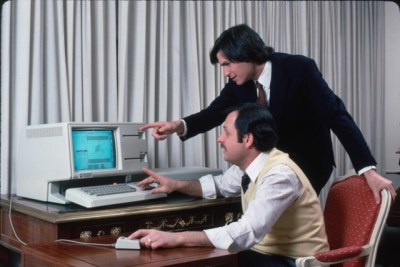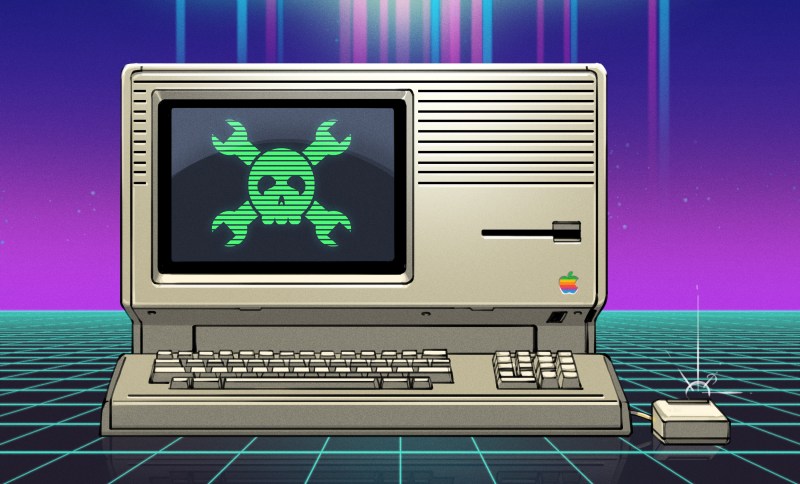Forty years ago, on January 19th of 1983, Apple released the Lisa, which was in many ways a revolutionary system. On January 19th of 2023, to celebrate the system’s 40th birthday, the Computer History Museum released the source code for Lisa OS version 3.1 under the Apple Academic License Agreement. Written in Pascal, the source includes over 1,300 source files, covering the OS itself, the Lisa Toolkit development system and a number of applications. The questions one might ask at this point include what the Apple Lisa even is, and why it was such an important system in computer history.
This especially in light of the terrible flop that the Lisa turned out to be, with only 10,000 units sold over two years. Part of this failure was definitely due to the introductory price, that was set at $9,995 (over $27,000 in 2021 dollars). Although it featured an OS with memory protection, despite the lack of an MMU on the Motorola 68k, among other advanced features that placed it well beyond other desktop computers of the time, it got quickly crushed in the market by Apple’s MacIntosh, even after successive Lisa successor releases that sought to address its shortcomings.
What’s In A Name
Whether the Lisa system truly was named after Steve Job’s first daughter (Lisa Nicole Brennan), an acronym for ‘Locally Integrated Software Architecture’ (LISA) or some torturous backronym may be a factoid that is forever lost to the sands of time, but that the Lisa’s development was itself torturous is beyond question.
The idea for the system was sparked when Steve Jobs, as part of a delegation from Apple, visited PARC in 1979 and received a demonstration of SmallTalk on the Xerox Alto system, with its GUI and mouse-driven interface. In the mind of Jobs, the Lisa would be the first commercialized, GUI-equipped desktop computer. At the time Apple was trying to develop a successor to the Apple ][, which was a best-selling, but still command line-based system.
Using the Motorola 32-bit 68000 MPU as the core, the new system would feature an object-oriented programming language — Object Pascal — hard drive storage, and a GUI- and mouse-driven interface on top of Lisa OS. Even as the project proceeded, Jobs was removed from the Lisa project by the Apple board of directors in 1982, which is where Steve Jobs’ role in the Lisa ends and the success story of the MacIntosh begins.

Although the Lisa was still finished and released, it was the MacIntosh that would see many upgrades and improvements based on lessons learned with the Lisa. In that sense the MacIntosh is the spiritual successor of the Lisa, which itself derives from Xerox’s Alto. As a low-cost desktop system, the MacIntosh did not feature the same high-end specs as the Lisa, but as a commercial success it opened new avenues for successor systems. Meanwhile the Lisa 2 was released in 1984, with a range of cost-cutting measures, such as dropping the twin Twiggy floppy drives for a single 3.5″ 400 kB FDD and lowering the amount of installed RAM.
Interestingly, the MacIntosh development used the Lisa systems as test systems, including the development of the first MacIntosh software, since architecturally they were still quite similar. The Lisa range of Apple computers would reach their end with the Lisa 2/10 (later rebranded as the MacIntosh XL). In 1986 the Lisa line of computers along with Lisa OS was officially discontinued.
The Lisa Legacy
It’s notable that despite Steve Jobs’ disbelief that Xerox would not simply commercialize the Alto system, Xerox ultimately would release the AMD Am2900-based Xerox Star 8010 in 1981, for a measly $16,595 (in 2021 dollars: $49,460). This meant that despite the overlap in features between Xerox’s and Apple’s offerings, Xerox targeted the government and research markets.
The Lisa remained trapped in a kind of limbo between the need to be as cost-effective as possible, while offering advanced features such as memory protection. The MacIntosh did not bother with such features, which allowed its MacOS to run faster on the same hardware, even if it was more prone to crashing and locking up.

As noted by Byte Magazine in its February 1983 preview of the Lisa, many people were interested in the features offered by the system, especially in comparison with the IBM PC that was making waves at the time. The mouse-based OS was, at the time, a revolution. They expressed the hope that Apple would figure out a way to offer these features at an affordable price, which as we now know never came to fruition. At least not within the Lisa range of computers, but in a sense the PowerPC-based Macs would. When OS X replaced MacOS and gave it the memory protection and other features that Lisa OS had pioneered years prior, it would have felt to many like justification for the effort spent on Lisa OS and the underlying hardware.
Perhaps that Lisa was simply ahead of its time, trying to hit features at a price target that was not yet achievable. Lisa OS was forced to implement its memory protection purely in software, which put a lot more strain on the already fairly anemic CPU. The task- and document-based GUI brought a lot of new ideas to the table, some of which can still be seen in OS X (now again MacOS) today.
As a purely financial investment, the Lisa was a flop, but as a development platform and a turning point in computer history its value is perhaps beyond measurement.
















I had an Apple III for a while. Never turned it on. Sold more, but lost in history.
Wrote a sh*t ton of business SW for the Apple III in the 80’s.
Had massive problems with the reliability of the HW.
*pple tried to push the PCB trace sizes beyond a reliable limit for the technology of the day
Also wrote SW for one of first LISAs in my country.
The OS was way kool for the time and was crunched down into ROMS for the Mac.
One of the great SW achievements of tuhe time….
The LISA was simply way too expensive & the non-standard floppies were a flop (groan!)
BTW: My information was that LISA orignally stood for “Let’s Invent Some Acronym”
There was a story about a German tinkerer who re-created the Lisa using discreet parts.
He even patched Mac OS aka System over the years to run on it. System 7 was the last one, I believe.
He also built Lisas for his friends, afaik.
As you may know, it was possible to use Mac Works to get System running on the Lisa.
There were differences, of course. Aspect ratio of the pels, floppy formats etc.
But many Mac applications using the Mac Toolkit functions would run.
That’s very interesting – can you perhaps remember more details? I know that a number of students built Apple ][ clones and sold them out of their student dorms (e.g. in Karlsruhe and Aachen), but I haven’t heard of someone building a Lisa clone. Fascinating…
Hi, yes, gladly. I’ve seen some comments about the story recently on golem.de; here’s the most detailed one, I think:
https://tinyurl.com/3wd8he36
Thanks for the link – it would be great to be able invite this Karl to tell the story of his projects to my students (we’re more or less around the corner here)…
There’s another article about Benjamin Heidesperger, an author who worked for the German “MacUP” magazine, who wrote a tutorial on building your own Mac from scratch in the 1980s: see page 7 of https://vcfb.de/2016/Programm_VCFB_2016.pdf (sorry, in German).
Correction: Benjamin Heidersberger, see https://de.wikipedia.org/wiki/Benjamin_Heidersberger
Seems my German is getting better, I understood “Game Room”, lol. In all seriousness, maybe I should work on my German, would be cool to see the junk they were working on without full access to the American and British market (and Japan, for that matter…)
Kind of the history of. Lisa, NeXT. Ahead of, but unaffordable.
Wasn’t LISA the case where Jobs wanted his engineers to implement a full modern multitasking OS but wanted them to implement it in ROM just like the Apple computers because RAM chips were too expensive – and then got into fights with everyone because he just didn’t understand that he was pushing a square peg through a round hole.
The Amiga 1000 story was different, by the way.
Kick Start 1 was distributed on diskette firsr, because it wasn’t finished.
Later on, the boot loader ROM was replaced by a set of ROMs/EPROMs holding Kick Start. The boot loader functionality was still retained, of course. Booter games still used it.
The Atari ST, the Jackintosh, had TOS in ROM, too. It can load extension from disks or HDDs, nevertheless.
Technically, using ROM is not dumb. Also from a licensing point if view.
ROM is permanent and cannot be modified at runtime. To do so, Shadow Memory is required.
The very first versions of the ST (I had a 260ST – low-cost “unbundled” version of the 520ST which also had 512kB RAM, but you could supply your own monitor, mouse and floppy drive) also only had a bootloader in ROM only using 2 of the 6 ROM sockets and loaded TOS from floppy. In turn, not a lot of RAM was left for programs. You could switch the ROMs to TOS ROMs later, of course (by then you would have also added another 512kB by soldering 41256 DRAM chips on top of the existing ones…). Details at https://ctrl-alt-rees.com/2021-05-07-atari-260st-story-tos-floppy-boot-process-and-how-much-ram.html
Thank you for the link! 🙂👍
>Technically, using ROM is not dumb.
Unless you want dynamically loaded libraries, which makes the point moot.
On the A1000 you had to load kickstart before you could boot a game. I don’t think anyone made “kickstart” games which loaded in place of kickstart which would only run on the A1000.
Post-A1000 Amigss had no problems loading newer libraries into RAM that replaced libraries that were in ROM. So it was definitely a solvable problem, but it did consume system RAM which was limited in the early days of Mac’s and Amigss.
In later years, when RAM became cheap, there was a tool for the Amiga to copy the ROM to RAM, which would allow the OS to run faster than it could natively run from ROM.
Very well written. Thank you.
In Brazil back in 1983 I had the opportunity to see one in person.
And I mean “see”, because its owner was so jealous as to not to let anyone else even power it on, much less use it.
I remember him saying it was “the future”.
Glad to see the future came and left him and the Lisa behind by bringing us much better and much, much more cost-effective systems in the form of inexpensive and open hardware and software.
I for one don’t miss these “good old days”at all.
It didn’t help that the Lisa’s 68000 to run all the new innovative software was only 5MHz.
Burrell Smith, the wizard designing upcoming Macintosh (at 8MHz) offered to replace the still-unreleased Lisa motherboard with a cheaper, simpler design. He impressed the Lisa team, but in the end they feared losing time on a redesign and didn’t change it. And was released late anyway.
https://www.folklore.org/StoryView.py?project=Macintosh&story=Square_Dots.txt
Title’s a little deceptive. Article’s still nicely written tho so I’m not complaining too hard here.
I was one of the lucky ones to buy a LIDA new…
It was used to write user manuals for the burgeoning PC based products that were being released, and on one occasionI wrote some code to emulate a CAD workstation on a TV commercial shoot.
I probably broke even over a couple of years, but eventually swapped it for a 4MHz PC clone – because Apple just weren’t interested in helping individual developers with exhorbitant developer licensing fees.
I wonder why the author consistently mis-capitalizes Macintosh.